Ojibwe
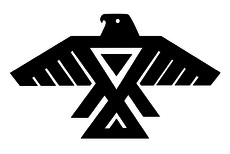 Symbol of the Anishinaabe people | |
| Total population | |
|---|---|
| (170,742 in United States(2010) [1]) | |
| Regions with significant populations | |
|
Canada (Quebec, Ontario, Manitoba) United States (Michigan, Wisconsin, Minnesota, North Dakota) | |
| Languages | |
| English, Ojibwe | |
| Religion | |
| Midewiwin, Catholicism, Methodism | |
| Related ethnic groups | |
| Ottawa, Potawatomi and other Algonquian peoples |

The Ojibwe, Ojibwa, or Chippewa are a group of indigenous peoples in North America. There are Ojibwe communities in both Canada and the United States. In Canada, they are the second-largest population among First Nations, surpassed only by the Cree. In the United States, they have the fourth-largest population among Native American tribes, surpassed only by the Navajo, Cherokee, and Lakota.
Because many Ojibwe were formerly located around the outlet of Lake Superior, which the French colonists called Sault Ste. Marie for its rapids, the early Canadian settlers referred to the Ojibwe as Saulteurs. Ojibwe who subsequently moved to the prairie provinces of Canada have retained the name Saulteaux. This is disputed since some scholars believe that only the name migrated west.[2] Ojibwe who were originally located along the Mississagi River and made their way to southern Ontario are known as the Mississaugas.[3]
The Ojibwe Peoples are a major component group of the Anishinaabe-speaking peoples, a branch of the Algonquian language family. The Anishinaabe peoples include the Algonquin, Nipissing, Oji-Cree, Odawa and the Potawatomi. The majority of the Ojibwe peoples live in Canada. There are 77,940 mainline Ojibwe; 76,760 Saulteaux and 8,770 Mississaugas, organized in 125 bands, and living from western Quebec to eastern British Columbia. As of 2010, Ojibwe in the U.S. number 170,742.[1]
The Ojibwe are historically known for their crafting of birch bark canoes, their sacred birch bark scrolls, the use of cowrie shells for trading, the cultivation of wild rice, and the use of copper arrow points. In 1745, they adopted guns from the British to defeat the Dakota in the Lake Superior area, pushing them to the south and west.
The Ojibwe Nation was the first to set the agenda with European-Canadian leaders by signing detailed treaties before they allowed many European settlers into their western areas. Their Midewiwin Society is well respected as the keeper of detailed and complex scrolls of events, oral history, songs, maps, memories, stories, geometry, and mathematics.[4]
Name
The autonym for this group of Anishinaabeg is Ojibwe (plural: Ojibweg). This name is commonly anglicized as "Ojibwa" or "Ojibway". The name "Chippewa" is an alternative anglicization. Although many variations exist in literature, "Chippewa" is more common in the United States and "Ojibwa" predominates in Canada, but both terms are used in each country. In many Ojibwe communities throughout Canada and the U.S. since the late 20th century, more members have been using the generalized name Anishinaabe(-g).
The exact meaning of the name Ojibwe is not known; the most common explanations for the name derivations are:
- ojiibwabwe (/o/ + /jiibw/ + /abwe/), meaning "those who cook\roast until it puckers", referring to their fire-curing of moccasin seams to make them waterproof.[5] Some 19th-century sources say this name described a method of ritual torture that the Ojibwe applied to enemies.[6]
- ozhibii'iwe (/o/ + /zhibii'/ + /iwe/), meaning "those who keep records [of a Vision]", referring to their form of pictorial writing, and pictographs used in Midewiwin sacred rites;[7] or
- ojiibwe (/o/ + /jiib/ + /we/), meaning "those who speak-stiffly"\"those who stammer", an exonym or name given to them by the Cree, who described the Ojibwe language for its differences from their own.[8]
Language
The Ojibwe language is known as Anishinaabemowin or Ojibwemowin, and is still widely spoken, although the number of fluent speakers has declined sharply. Today, most of the language's fluent speakers are elders. Since the early 21st century, there is a growing movement to revitalize the language, and restore its strength as a central part of Ojibwe culture. The language belongs to the Algonquian linguistic group, and is descended from Proto-Algonquian. Its sister languages include Blackfoot, Cheyenne, Cree, Fox, Menominee, Potawatomi, and Shawnee among the northern Plains tribes. Anishinaabemowin is frequently referred to as a "Central Algonquian" language; however, Central Algonquian is an area grouping rather than a linguistic genetic one.
Ojibwemowin is the fourth-most spoken Native language in North America (US and Canada) after Navajo, Cree, and Inuktitut. Many decades of fur trading with the French established the language as one of the key trade languages of the Great Lakes and the northern Great Plains.
The popularity of the epic poem The Song of Hiawatha, written by Henry Wadsworth Longfellow in 1855, publicized the Ojibwe culture. The epic contains many toponyms that originate from Ojibwe words.
History
Pre-contact and spiritual beliefs
According to their tradition, and from recordings in birch bark scrolls, the Ojibwe originated in North America (called "Turtle Islands"), and along the east Pacific Ocean. They traded widely across the continent for thousands of years as they migrated, and knew of the canoe routes to move north, west to east, and then south in the Americas. The identification of the Ojibwe as a culture or people may have occurred in response to contact with Europeans. The Europeans preferred to deal with bounded groups and tried to identify those they encountered.[9]
According to their oral history, seven great miigis (radiant/iridescent) beings appeared to the peoples in the Waabanakiing (Land of the Dawn, i.e., Eastern Land) to teach them the mide way of life. One of the seven great miigis beings was too spiritually powerful and killed the peoples in the Waabanakiing when they were in its presence. The six great miigis beings remained to teach, while the one returned into the ocean. The six great miigis beings established doodem (clans) for the peoples in the east, symbolized by animal, fish or bird species. The five original Anishinaabe doodem were the Wawaazisii (Bullhead), Baswenaazhi (Echo-maker, i.e., Crane), Aan'aawenh (Pintail Duck), Nooke (Tender, i.e., Bear) and Moozoonsii (Little Moose), then these six miigis beings returned into the ocean as well. If the seventh miigis being stayed, it would have established the Thunderbird doodem.
At a later time, one of these miigis appeared in a vision to relate a prophecy. It said that if the Anishinaabeg did not move further west, they would not be able to keep their traditional ways alive because of the many new settlements and pale-skinned peoples who would arrive soon in the east. Their migration path would be symbolized by a series of smaller Turtle Islands, which was confirmed with miigis shells (i.e., cowry shells). After receiving assurance from their "Allied Brothers" (i.e., Mi'kmaq) and "Father" (i.e., Abenaki) of their safety to move inland, the Anishinaabeg gradually migrated west along the Saint Lawrence River to the Ottawa River to Lake Nipissing, and then to the Great Lakes.
The first of the smaller Turtle Islands was Mooniyaa, where Mooniyaang (present-day Montreal) developed. The "second stopping place" was in the vicinity of the Wayaanag-gakaabikaa (Concave Waterfalls, i.e., Niagara Falls). At their "third stopping place", near the present-day city of Detroit, Michigan, the Anishinaabeg divided into six groups, of which the Ojibwe was one.
The first significant new Ojibwe culture-center was their "fourth stopping place" on Manidoo Minising (Manitoulin Island). Their first new political-center was referred to as their "fifth stopping place", in their present country at Baawiting (Sault Ste. Marie).
Continuing their westward expansion, the Ojibwe divided into the "northern branch", following the north shore of Lake Superior, and the "southern branch", along its south shore.
As the peoples continued to migrate westward, the "northern branch" divided into a "westerly group" and a "southerly group". The "southern branch" and the "southerly group" of the "northern branch" came together at their "sixth stopping place" on Spirit Island (46°41′15″N 092°11′21″W / 46.68750°N 92.18917°W) located in the Saint Louis River estuary at the western end of Lake Superior. (This has since been developed as the present-day Duluth/Superior cities.) The people were directed in a vision by the miigis being to go to the "place where there is food (i.e., wild rice) upon the waters." Their second major settlement, referred to as their "seventh stopping place", was at Shaugawaumikong (or Zhaagawaamikong, French, Chequamegon) on the southern shore of Lake Superior, near the present La Pointe, Wisconsin.
The "westerly group" of the "northern branch" migrated along the Rainy River, Red River of the North, and across the northern Great Plains until reaching the Pacific Northwest. Along their migration to the west, they came across many miigis, or cowry shells, as told in the prophecy.
Post-contact with Europeans

The first historical mention of the Ojibwe occurs in the French Jesuit Relation of 1640, a report by the missionary priests to their superiors in France. Through their friendship with the French traders (coureur des bois and voyageurs), the Ojibwe gained guns, began to use European goods, and began to dominate their traditional enemies, the Lakota and Fox to their west and south. They drove the Sioux from the Upper Mississippi region to the area of the present-day Dakotas, and forced the Fox down from northern Wisconsin. The latter allied with the Sauk for protection.
By the end of the 18th century, the Ojibwe controlled nearly all of present-day Michigan, northern Wisconsin, and Minnesota, including most of the Red River area. They also controlled the entire northern shores of lakes Huron and Superior on the Canadian side and extending westward to the Turtle Mountains of North Dakota. In the latter area, the French Canadians called them Ojibwe or Saulteaux.

The Ojibwe (Chippewa) were part of a long-term alliance with the Anishinaabe Ottawa and Potawatomi peoples, called the Council of Three Fires. They fought against the Iroquois Confederacy, based mainly to the southeast of the Great Lakes in present-day New York, and the Sioux to the west. The Ojibwe expanded eastward, taking over the lands along the eastern shores of Lake Huron and Georgian Bay.
Often, treaties known as "Peace and Friendship Treaties" were made to establish community bonds between the Ojibwe and the European settlers. These established the groundwork for cooperative resource-sharing between the Ojibwe and the settlers. The United States and Canada viewed later treaties offering land cessions as offering territorial advantages. The Ojibwe did not understand the land cession terms in the same way because of the cultural differences in understanding the uses of land. The governments of the US and Canada considered land a commodity of value that could be freely bought, owned and sold.
The Ojibwe believed it was a fully shared resource, along with air, water and sunlight—despite having an understanding of "territory". At the time of the treaty councils, they could not conceive of separate land sales or exclusive ownership of land. Consequently, today, in both Canada and the US, legal arguments in treaty-rights and treaty interpretations often bring to light the differences in cultural understanding of treaty terms to come to legal understanding of the treaty obligations.[10]
In part due to its long trading alliance, the Ojibwe allied with the French against Great Britain and its colonists in the Seven Years' War (also called the French and Indian War).[11] After losing the war in 1763, France was forced to cede its colonial claims to lands in Canada and east of the Mississippi River to Britain. After adjusting to British colonial rule, the Ojibwe allied with them and against the United States in the War of 1812. They had hoped that a British victory could protect them against United States settlers' encroachment on their territory.
Following the war, the United States government tried to forcibly remove all the Ojibwe to Minnesota, west of the Mississippi River. The Ojibwe resisted, and there were violent confrontations. In the Sandy Lake Tragedy, the US killed several hundred Ojibwe. Through the efforts of Chief Buffalo and the rise of popular opinion in the US against Ojibwe removal, the bands east of the Mississippi were allowed to return to reservations on ceded territory. A few families were removed to Kansas as part of the Potawatomi removal.

In British North America, the Royal Proclamation of 1763 following the Seven Years' War governed the cession of land by treaty or purchase . Subsequently, France ceded most of the land in Upper Canada to Great Britain. Even with the Jay Treaty signed between Great Britain and the United States following the American Revolutionary War, the newly formed United States did not fully uphold the treaty. As it was still preoccupied by war with France, Great Britain ceded to the United States much of the lands in Ohio, Indiana, Michigan, parts of Illinois and Wisconsin, and northern Minnesota and North Dakota to settle the boundary of their holdings in Canada.
In 1807, the Ojibwe joined three other tribes, the Odawa, Potawatomi and Wyandot people, in signing the Treaty of Detroit. The agreement, between the tribes and William Hull, representing the Michigan Territory, gave the United States a portion of today's Southeastern Michigan and a section of Ohio near the Maumee River. The tribes were able to retain small pockets of land in the territory.[12]
In Canada, many of the land cession treaties the British made with the Ojibwe provided for their rights for continued hunting, fishing and gathering of natural resources after land sales. The government signed numbered treaties in northwestern Ontario, Manitoba, Saskatchewan, and Alberta. British Columbia had no signed treaties until the late 20th century, and most areas have no treaties yet. The government and First Nations are continuing to negotiate treaty land entitlements and settlements. The treaties are constantly being reinterpreted by the courts because many of them are vague and difficult to apply in modern times. The numbered treaties were some of the most detailed treaties signed for their time. The Ojibwe Nation set the agenda and negotiated the first numbered treaties before they would allow safe passage of many more British settlers to the prairies.
During its Indian Removal of the 1830s, the US government attempted to relocate tribes from the east to the west of the Mississippi River as the white pioneers increasingly migrated west. By the late 19th century, the government policy was to move tribes onto reservations within their territories. The government attempted to do this to the Anishinaabe in the Keweenaw Peninsula in the Upper Peninsula of Michigan.
Culture

The Ojibwe live in groups (otherwise known as "bands"). Most Ojibwe, except for the Great Plains bands, lived a sedentary lifestyle, engaging in fishing and hunting to supplement the women's cultivation of numerous varieties of maize and squash, and the harvesting of manoomin (wild rice). Their typical dwelling was the wiigiwaam (wigwam), built either as a waginogaan (domed-lodge) or as a nasawa'ogaan (pointed-lodge), made of birch bark, juniper bark and willow saplings.

They developed a form of pictorial writing, used in religious rites of the Midewiwin and recorded on birch bark scrolls and possibly on rock. The many complex pictures on the sacred scrolls communicate much historical, geometrical, and mathematical knowledge. The use of petroforms, petroglyphs, and pictographs was common throughout the Ojibwe traditional territories. Petroforms and medicine wheels were a way to teach the important concepts of four directions and astronomical observations about the seasons, and to use as a memorizing tool for certain stories and beliefs.
Ceremonies also used the miigis shell (cowry shell), which is found naturally in distant coastal areas. Their use of such shells demonstrates there was a vast trade network across the continent at some time. The use and trade of copper across the continent has also been proof of a large trading network that took place for thousands of years, as far back as the Hopewell tradition. Certain types of rock used for spear and arrow heads were also traded over large distances.
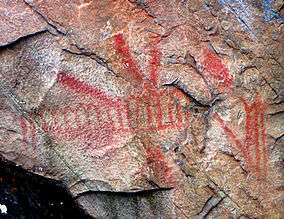
During the summer months, the people attend jiingotamog for the spiritual and niimi'idimaa for a social gathering (pow-wows or "pau waus") at various reservations in the Anishinaabe-Aki (Anishinaabe Country). Many people still follow the traditional ways of harvesting wild rice, picking berries, hunting, making medicines, and making maple sugar. Many of the Ojibwe take part in sun dance ceremonies across the continent. The sacred scrolls are kept hidden away until those who are worthy and respect them are given permission to see and interpret them properly.
The Ojibwe would not bury their dead in a burial mound. Many erect a jiibegamig or a "spirit-house" over each mound. A traditional burial mound would typically have a wooden marker, inscribed with the deceased's doodem (clan sign). Because of the distinct features of these burials, Ojibwe graves have been often looted by grave robbers. In the United States, many Ojibwe communities safe-guard their burial mounds through the enforcement of the 1990 Native American Graves Protection and Repatriation Act.
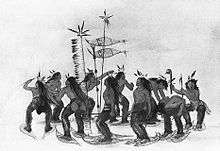
As with various other North American peoples, the Ojibwe culture includes a third gender. Ojibwe Two-Spirit women take on men's roles, classified as either "Iron Woman" or "Half Sky". Generally, two-spirit men practiced Shamanism and it was taboo for women to take on this role, but a two-spirit following this path was called an Iron Woman. The Half Sky two-spirit would be physically good at a man's trade (like hunting). Also, there is an instance when a wife becomes a widow and takes on her husband's manly deeds; this woman is called a "Woman Covered All Over". (Landes 153, 176, 178-179, and Merriam- Webster Dictionary).
Several Ojibwe bands in the United States cooperate in the Great Lakes Indian Fish & Wildlife Commission, which manages the treaty hunting and fishing rights in the Lake Superior-Lake Michigan areas. The commission follows the directives of U.S. agencies to run several wilderness areas. Some Minnesota Ojibwe tribal councils cooperate in the 1854 Treaty Authority, which manages their treaty hunting and fishing rights in the Arrowhead Region. In Michigan, the Chippewa-Ottawa Resource Authority manages the hunting, fishing and gathering rights about Sault Ste. Marie, and the resources of the waters of lakes Michigan and Huron. In Canada, the Grand Council of Treaty No. 3 manages the Treaty 3 hunting and fishing rights related to the area around Lake of the Woods.
Kinship and clan system
Traditionally, the Ojibwe had a patrilineal system, in which children were considered born to the father's clan.[13] For this reason, children with French or English fathers were considered outside the clan and Ojibwe society unless adopted by an Ojibwe male. They were sometimes referred to as "white" because of their fathers, regardless if their mothers were Ojibwe, as they had no official place in the Ojibwe society. The people would shelter the woman and her children, but they did not have the same place in the culture as children born to Ojibwe fathers.
Ojibwe understanding of kinship is complex, and includes not only the immediate family but also the extended family. It is considered a modified bifurcate merging kinship system. As with any bifurcate-merging kinship system, siblings generally share the same kinship term with parallel cousins because they are all part of the same clan. The modified system allows for younger siblings to share the same kinship term with younger cross-cousins. Complexity wanes further from the speaker's immediate generation, but some complexity is retained with female relatives. For example, ninooshenh is "my mother's sister" or "my father's sister-in-law"—i.e., my parallel-aunt, but also "my parent's female cross-cousin". Great-grandparents and older generations, as well as great-grandchildren and younger generations, are collectively called aanikoobijigan. This system of kinship reflects the Anishinaabe philosophy of interconnectedness and balance among all living generations, as well as of all generations of the past and of the future.
The Ojibwe people were divided into a number of odoodeman (clans; singular: doodem) named primarily for animals and birds totems (pronounced doodem). The five original totems were Wawaazisii (Bullhead), Baswenaazhi ("Echo-maker", i.e., Crane), Aan'aawenh (Pintail Duck), Nooke ("Tender", i.e., Bear) and Moozwaanowe ("Little" Moose-tail). The Crane totem was the most vocal among the Ojibwe, and the Bear was the largest – so large, that it was sub-divided into body parts such as the head, the ribs and the feet. Each clan had certain responsibilities among the people. People had to marry a spouse from a different clan.
Traditionally, each band had a self-regulating council consisting of leaders of the communities' clans, or odoodemaan. The band was often identified by the principal doodem. In meeting others, the traditional greeting among the Ojibwe peoples is, "What is your 'doodem'?" ("Aaniin gidoodem?" or "Awanen gidoodem?") The response allows the parties to establish social conduct by identifying as family, friends or enemies. Today, the greeting has been shortened to "Aanii". Pronounced; (Ah-nee)
Spiritual beliefs


The Ojibwe have a number of spiritual beliefs passed down by oral tradition under the Midewiwin teachings. These include a creation story and a recounting of the origins of ceremonies and rituals. Spiritual beliefs and rituals were very important to the Ojibwe because spirits guided them through life. Birch bark scrolls and petroforms were used to pass along knowledge and information, as well as for ceremonies. Pictographs were also used for ceremonies.
The sweatlodge is still used during important ceremonies about the four directions, when oral history is recounted. Teaching lodges are common today to teach the next generations about the language and ancient ways of the past. The traditional ways, ideas, and teachings are preserved and practiced in such living ceremonies.
The Ojibwe crafted the dreamcatcher. They believe that if one is hung above the head of a sleeper, it will catch and trap bad dreams, preventing them from reaching the dreamer. Traditional Ojibwe use dreamcatchers only for children, as they believe that adults should be able to interpret their dreams, good or bad, and use them in their lives.
Ethnobotany
Herbs used as medicine by the Ojibwe include Agrimonia gryposepala, used for urinary problems,[14] and pinus strobus, the resin of which was used to treat infections and gangrene. Essiac, an herbal mixture used in tea was given its name by Rene Caisse ("caisse" spelt backwards). The Ojibwe call it "The Tea of Life" and it consists of four herbs native to the wilderness of Ontario, Canada.[15][16] The roots of Symphyotrichum novae-angliae are smoked in pipes to attract game.[17]
Representation in popular culture
Literature
- In his story, "Fathers and Sons", Ernest Hemingway uses two Ojibwe as secondary characters.
- The legend of the Ojibwe Wendigo, in which tribesmen identify with a cannibalistic monster and prey on their families, has many levels of meaning. It points to the consequences of greed and the destruction it can cause. European-American authors Algernon Blackwood, Thomas Pynchon, Ramsey Campbell and Stephen King have referred to this story in their fiction. It has been co-opted into the Cthulhu Mythos by August Derleth and subsequently by a number of other authors.
- Novelist Louise Erdrich (Ojibwe) has written about her people and culture in numerous novels based in fictional settlements, including Tracks, Love Medicine, The Bingo Palace and The Round House, among others. Her novels cover a range of history and individuals, returning to her fictional families over time, and the complex relations between the Anishinaabe and Europeans.
- Keewaydinoquay Peschel, a medicine woman, has written books on ethnobotany and books for children.
- Gerald Vizenor (Ojibwe), a literary theorist and writer, has drawn extensively on Anishinaabe philosophies of language.
- William Kent Krueger has written a series of crime novels chronicling the adventures of a character named Corcoran "Cork" O'Connor, an Ojibwe with partial European ancestry who works as the sheriff of Aurora, Minnesota. The novels express how Cork uses both his Ojibwe and Irish-American heritage to solve local crimes.[18] Ojibwe spirituality is an important element of the subtext of many of the storylines.[18]
- In Elmore Leonard's Killshot, hit man Armand "Blackbird" Degas is Ojibway and French Canadian (also known as Metis, as many of these mixed-race people banded together and formed their own culture).
Music
- Composer Ferde Grofe composed a movement, "Father of the Waters", of his Mississippi Suite, which represents the Chippewa Indians and the headwaters of the Mississippi.
Television
- In several episodes of the HBO series The Sopranos (e.g., "Mayham" and "The Fleshy Part of the Thigh"), Tony Soprano recovers from a gunshot wound. He reflects on an Ojibwe saying left by his bed: "Sometimes I go about in pity for myself, and all the while, a great wind carries me across the sky".
Bands
In his History of the Ojibway People (1855), William W. Warren recorded 10 major divisions of the Ojibwe in the United States. He mistakenly omitted the Ojibwe located in Michigan, western Minnesota and westward, and all of Canada. When identified major historical bands located in Michigan and Ontario are added, the count becomes 15:
| English Name | Ojibwe Name (in double-vowel spelling) |
Location |
|---|---|---|
| Saulteaux | Baawitigowininiwag | Sault Ste. Marie area of Ontario and Michigan |
| Border-Sitters | Biitan-akiing-enabijig | St. Croix-Namekagon River valleys in eastern Minnesota and northern Wisconsin |
| Lake Superior Band | Gichi-gamiwininiwag | south shore of Lake Superior |
| Mississippi River Band | Gichi-ziibiwininiwag | upper Mississippi River in Minnesota |
| Rainy Lake Band | Goojijiwininiwag | Rainy Lake and River, about the northern boundary of Minnesota |
| Ricing-Rails | Manoominikeshiinyag | along headwaters of St. Croix River in Wisconsin and Minnesota |
| Pillagers | Makandwewininiwag | North-central Minnesota and Mississippi River headwaters |
| Mississaugas | Misi-zaagiwininiwag | north of Lake Erie, extending north of Lake Huron about the Mississaugi River |
| Algonquins (Nipissing) | Odishkwaagamiig | Quebec-Ontario border, about Lake Nipissing |
| Dokis Band (Dokis's and Restoule's bands) | N/A | Along French River region in Ontario, near Lake Nipissing |
| Ottawa Lake (Lac Courte Oreilles) Band | Odaawaa-zaaga'iganiwininiwag | Lac Courte Oreilles, Wisconsin |
| Bois Forte Band | Zagaakwaandagowininiwag | north of Lake Superior |
| Lac du Flambeau Band | Waaswaaganiwininiwag | head of Wisconsin River |
| Muskrat Portage Band | Wazhashk-Onigamininiwag | northwest side of Lake Superior at the Canadian border |
| Nopeming Band | Noopiming Azhe-ininiwag | northeast of Lake Superior and west of Lake Nipissing |
These 15 major divisions developed into the following Ojibwe Bands and First Nations of today. Bands are listed under their respective tribes where possible. See also the listing of Saulteaux communities.
- Aamjiwnaang First Nation
- Aroland First Nation
- Batchewana First Nation of Ojibways
- Bay Mills Indian Community
- Biinjitiwabik Zaaging Anishnabek First Nation
- Burt Lake Band of Chippewa and Ottawa Indians
- Chapleau Ojibway First Nation
- Chippewas of Kettle and Stony Point
- Chippewas of Lake Simcoe and Huron (Historical)
- Beausoleil First Nation
- Chippewas of Georgina Island First Nation
- Chippewas of Rama First Nation (formerly known as Chippewas of Mnjikaning First Nation)
- Chippewas of Nawash Unceded First Nation
- Chippewa of the Thames First Nation
- Chippewas of Saugeen Ojibway Territory (Historical)
- Chippewa Cree Tribe of Rocky Boys Indian Reservation
- Curve Lake First Nation
- Cutler First Nation
- Dokis First Nation
- Eabametoong First Nation
- First Nation of Ojibwe California
- Grand Traverse Band of Ottawa and Chippewa Indians
- Garden River First Nation
- Henvey Inlet First Nation
- Grassy Narrows First Nation (Asabiinyashkosiwagong Nitam-Anishinaabeg)
- Islands in the Trent Waters
- Keeseekoowenin Ojibway First Nation
- Koocheching First Nation
- Lac des Mille Lacs First Nation
- Lac La Croix First Nation
- Lac Seul First Nation
- Lake Nipigon Ojibway First Nation
- Lake Superior Chippewa Tribe
- Bad River Chippewa Band
- Lac Vieux Desert Band of Lake Superior Chippewa
- Keweenaw Bay Indian Community
- L'Anse Band of Chippewa Indians
- Ontonagon Band of Chippewa Indians
- Lac Courte Oreilles Band of Lake Superior Chippewa Indians
- Bois Brule River Band of Lake Superior Chippewa
- Chippewa River Band of Lake Superior Chippewa
- Lac Courte Oreilles Band of Lake Superior Chippewa Indians
- Removable St. Croix Chippewa Indians of Wisconsin
- Lac du Flambeau Band of Lake Superior Chippewa
- Red Cliff Band of Lake Superior Chippewa
- Sokaogon Chippewa Community
- St. Croix Chippewa Indians of Wisconsin
- Little Shell Tribe of Chippewa Indians of Montana
- Little Traverse Bay Bands of Odawa Indians
- Mackinac Bands of Chippewa and Ottawa Indians
- Magnetawan First Nation
- Minnesota Chippewa Tribe
- Bois Forte Band of Chippewa
- Bois Forte Band of Chippewa
- Lake Vermilion Band of Lake Superior Chippewa
- Little Forks Band of Rainy River Saulteaux
- Fond du Lac Band of Lake Superior Chippewa
- Grand Portage Band of Chippewa
- Leech Lake Band of Ojibwe
- Cass Lake Band of Chippewa
- Lake Winnibigoshish Band of Chippewa
- Leech Lake Band of Pillagers
- Removable Lake Superior Bands of Chippewa of the Chippewa Reservation
- White Oak Point Band of Mississippi Chippewa
- Mille Lacs Band of Ojibwe
- Mille Lacs Indians
- Sandy Lake Band of Mississippi Chippewa
- Rice Lake Band of Mississippi Chippewa
- St. Croix Band of Chippewa Indians of Minnesota
- Kettle River Band of Chippewa Indians
- Snake and Knife Rivers Band of Chippewa Indians
- White Earth Band of Chippewa
- Gull Lake Band of Mississippi Chippewa
- Otter Tail Band of Pillagers
- Rabbit Lake Band of Mississippi Chippewa
- Removable Mille Lacs Indians
- Removable Sandy Lake Band of Mississippi Chippewa
- Rice Lake Band of Mississippi Chippewa
- Bois Forte Band of Chippewa
- Mississaugi First Nation
- North Caribou Lake First Nation
- Ojibway Nation of Saugeen First Nation
- Ojibways of the Pic River First Nation
- Osnaburg House Band of Ojibway (Historical)
- Cat Lake First Nation
- Mishkeegogamang First Nation (formerly known as New Osnaburgh First Nation)
- Slate Falls First Nation
- Pembina Band of Chippewa Indians (Historical)
- Pikangikum First Nation
- Poplar Hill First Nation
- Red Lake Band of Chippewa Indians
- Lac des Bois Band of Chippewa Indians
- Sagamok Anishnawbek First Nation
- Saginaw Chippewa Tribal Council
- Sault Tribe of Chippewa Indians
- Saulteaux First Nation
- Shawanaga First Nation
- Southeast Tribal Council
- Berens River First Nation
- Bloodvein First Nation
- Brokenhead First Nation
- Buffalo Point First Nation (Saulteaux)
- Hollow Water First Nation
- Black River First Nation
- Little Grand Rapids First Nation
- Pauingassi First Nation (Saulteaux)
- Poplar River First Nation
- Turtle Mountain Band of Chippewa Indians
- Wabaseemoong Independent Nation
- Wabauskang First Nation
- Wabun Tribal Council
- Beaverhouse First Nation
- Brunswick House First Nation
- Chapleau Ojibwe First Nation
- Matachewan First Nation
- Mattagami First Nation
- Wahgoshig First Nation
- Wabigoon Lake Ojibway Nation
- Wahnapitae First Nation
- Walpole Island First Nation
- Washagamis Bay First Nation
- Whitefish Bay First Nation
- Whitefish Lake First Nation
- Whitefish River First Nation
- Whitesand First Nation
- Whitewater Lake First Nation
- Wikwemikong Unceded First Nation
Ojibwe people
- Ah-shah-way-gee-she-go-qua (Aazhawigiizhigokwe, Hanging Cloud), woman warrior
- David Wayne "Famous Dave" Anderson, entrepreneur
- Arron Asham, ice hockey player for the Pittsburgh Penguins
- Dennis Banks, activist
- James Bartleman, diplomat and author
- Adam Beach, actor and writer
- Carl Beam, artist
- Jason Behr, actor
- Clyde Bellecourt (White Earth Ojibwe), social activist
- Vernon Bellecourt (White Earth Ojibwe), social activist
- Chief Bender, baseball player
- Stephen Bonga, Ojibwe/African-American fur trader and interpreter[19]
- George Bonga, Ojibwe/African-American fur trader and interpreter
- Odell Borg, flutist and flute maker
- Benjamin Chee Chee, artist
- Henry Boucha, ice hockey player, United States Hockey Hall of Fame
- Al Hunter, poet
- George Copway, missionary and writer
- Eddy Cobiness, artist
- Kelly Church (Grand Traverse Band), basket weaver, painter, and birch bark biter
- Raven Davis, artist
- Jim Denomie, artist
- Patrick DesJarlait, painter and graphic artist
- Louise Erdrich (Turtle Mountain Chippewa), author
- Meegwun Fairbrother, actor and traditional singer and dancer[20]
- Phil Fontaine, politician
- William Gardner, one of the Untouchables
- Cara Gee, actor
- Philip B. Gordon, priest and activist
- Kraig Grady, composer, puppeteer
- Gordon Henry Jr., writer
- Virgil Hill, boxer
- Basil Johnston, historian and cultural essayist
- Peter Jones, missionary and writer
- Ke-che-waish-ke (Gichi-Weshkiinh, Buffalo), chief
- Keewaydinoquay Peschel, teacher, ethnobotanist
- Maude Kegg, author, cultural ambassador
- Wayne Keon, poet, author
- Winona LaDuke, activist and writer
- Carole LaFavor, writer
- Chief Little Bear, chief
- Joe Lumsden (Sault Tribe of Chippewa Indians), tribal chairman
- Loma Lyns, singer and songwriter
- Cody McCormick, ice hockey player for the Colorado Avalanche
- Medweganoonind, chief
- Rod Michano, AIDS activist and educator
- George Morrison, artist
- Norval Morrisseau, artist and founder of the Woodlands style of painting
- Ted Nolan, ice hockey player and coach, Jack Adams Award winner
- Jordan Nolan, professional ice hockey player
- Jim Northrup, columnist
- T. J. Oshie, National Hockey League player and member of the 2014 USA Olympic Men's Hockey team[21]
- O-zaw-wen-dib (Ozaawindib, Yellow Head), woman warrior, guide
- Francis Pegahmagabow, soldier
- Leonard Peltier, political activist, prisoner, author, artist
- Mel Pervais, entrepreneur
- Pun Plamondon, activist
- Tommy Prince, soldier
- Chief Rocky Boy, chief
- Buffy Sainte-Marie, singer, songwriter
- Thomas St. Germaine, football player
- Jane Johnston Schoolcraft, author, wife of Henry Rowe Schoolcraft
- Eric Schweig, actor
- Keith Secola, rock and blues singer
- Chris Simon, ice hockey player, Stanley Cup winner w/ 1996 Colorado Avalanche
- John Smith, Gaa-binagwiiyaas, chief, reported to have lived 137 years
- Albert Smoke, long-distance runner
- Drew Hayden Taylor, playwright, author and journalist
- Roy Thomas, artist
- David Treuer, author
- E. Donald Two-Rivers, poet and playwright
- Alfred Michael "Chief" Venne, athletic manager and coach
- Gerald Vizenor, author and educator
- Wawatam, chief
- Waabaanakwad (White Cloud), chief
- William Whipple Warren, first historian of the Ojibwe people, territorial legislator
- Crystal Shawanda, country music singer
- Justice Murray Sinclair, head of the Residential School System Truth and Reconciliation Committee
Ojibwe treaties
|
|
Gallery
-

A-na-cam-e-gish-ca (Aanakamigishkaang/"[Traces of] Foot Prints [upon the Ground]"), Ojibwe chief, from History of the Indian Tribes of North America
-

Bust of Aysh-ke-bah-ke-ko-zhay (Eshkibagikoonzhe or "Flat Mouth"), a Leech Lake Ojibwe chief
-
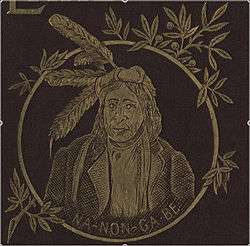
Chief Beautifying Bird (Nenaa'angebi), by Benjamin Armstrong, 1891
-

Bust of Beshekee, war chief, modeled 1855, carved 1856
-

Caa-tou-see, an Ojibwe, from History of the Indian Tribes of North America
-
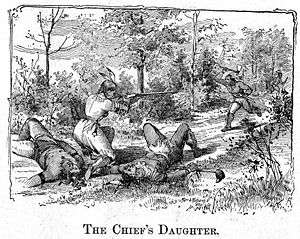
Hanging Cloud, a female Ojibwe warrior
-
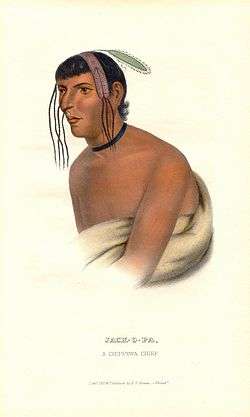
Jack-O-Pa (Shák'pí/"Six"), an Ojibwe/Dakota chief, from History of the Indian Tribes of North America
-

Kay be sen day way We Win, by Eastman Johnson, 1857
-

Kei-a-gis-gis, a Plains Ojibwe woman, painted by George Catlin
-
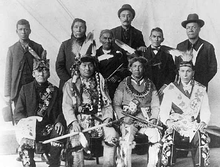
Leech Lake Ojibwe delegation to Washington, 1899
-

Chippewa baby teething on "Indians at Work" magazine while strapped to a cradleboard at a rice lake in 1940.
-

Milwaukee Ojibwe woman and baby, courtesy of the Wisconsin Historical Society
-

Ne-bah-quah-om, Ojibwe chief
-

"One Called From A Distance" (Midwewinind) of the White Earth Band, 1894.
-

Shaun Hedican, Eabametoong First Nation
-

Pee-Che-Kir, Ojibwe chief, painted by Thomas Loraine McKenney, 1843
-
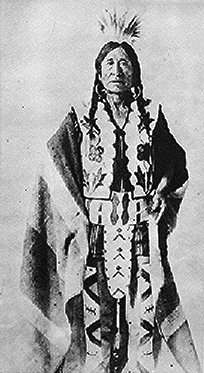
Ojibwe chief Rocky Boy
-

Ojibwe woman and child, from History of the Indian Tribes of North America
-

Tshusick, an Ojibwe woman, from History of the Indian Tribes of North America
-

Chief medicine man Axel Pasey and family at Grand Portage Minnesota.
-

Historic 1849 petition of Ojibwe chiefs [1]
See also
References
Notes
- 1 2 http://www.cdc.gov/minorityhealth/populations/REMP/aian.html
- ↑ Three Fires Unity: The Anishnaabeg of the Lake Huron Borderlands. Phil Bellfy. 2011. University of Nebraska.
- ↑ "First Nations Culture Areas Index". the Canadian Museum of Civilization.
- ↑ "Anishinabe". eMuseum @ Minnesota State University. Minnesota State University. Mankato. Retrieved 2010-03-16.
- ↑ "Microsoft Word - dictionary best for printing 2004 ever finalpdf.doc" (PDF). Retrieved 2011-01-02.
- ↑ Warren, William W. (1885; reprint: 1984) History of the Ojibway People. ISBN 0-87351-162-X
- ↑ Louise Erdrich, Books and Islands in Ojibwe Country (2003) Archived September 26, 2007 at the Wayback Machine
- ↑ Johnston, Basil. (2007) Anishinaubae Thesaurus ISBN 0-87013-753-0
- ↑ Anthony, David. The Horse, the Wheel and Language, Princeton University Press, 2007, p. 102
- ↑ "The Atlas of Canada: Historical Indian Treaties". Retrieved 2010-05-09.
- ↑ Gevinson, Alan. "Which Native American Tribes Allied Themselves with the French?" Teachinghistory.org, accessed 23 September 2011.
- ↑ "Treaty Between the Ottawa, Chippewa, Wyandot, and Potawatomi Indians". World Digital Library. 1807-11-17. Retrieved 2013-08-03.
- ↑ "Ojibwe Culture", Milwaukee Public Museum, accessed 10 December 2011
- ↑ Daniel E. Moerman (2009). Native American Medicinal Plants: An Ethnobotanical Dictionary. Timber Press. pp. 52–53. ISBN 0-88192-987-5.
- ↑ Native American Ethnobotany (University of Michigan - Dearborn) . accessed 1.13.2013
- ↑ Fernald, M., A. Kinsey, and R. Rollins. 1943. Edible Wild Plants. Harper & Row, NY.
- ↑ Densmore, Frances 1928 Uses of Plants by the Chippewa Indians. SI-BAE Annual Report #44:273-379 (p. 376)
- 1 2 "Cork O'Connor", Thrilling Detective
- ↑ "Portrait of Stephen Bonga", Wisconsin Historical Images, accessed 23 January 2014
- ↑ "Meegwun Fairbrother - ATLAS Stage Productions Canada". atlasstage.com.
- ↑ Oshie-Blogs. "Minnesota H.S. Section 8A Boy's Hockey Site: Keeway Gaaboo .... A Symbol Of Pride For Fighting Sioux". section8ahockeyblog.blogspot.com.
Bibliography'
- F. Densmore, Chippewa Customs (1929, repr. 1970)
- H. Hickerson, The Chippewa and Their Neighbors (1970)
- R. Landes, Ojibwa Sociology (1937, repr. 1969)
- R. Landes, Ojibwa Woman (1938, repr. 1971)
- F. Symington, The Canadian Indian (1969)
Further reading
- Aaniin Ekidong: Ojibwe Vocabulary Project. St. Paul: Minnesota Humanities Center, 2009.http://www.amazon.com/s/ref=nb_sb_ss_i_0_6?url=search-alias%3Dstripbooks&field-keywords=aaniin+ekidong&sprefix=aaniin
- Bento-Banai, Edward (2004). Creation- From the Ojibwa. The Mishomis Book.
- Child, Brenda J. (2014). My Grandfather's Knocking Sticks: Ojibwe Family Life and Labor on the Reservation. St. Paul, MN: Minnesota Historical Society Press.
- Danziger, E.J., Jr. (1978). The Chippewa of Lake Superior. Norman: University of Oklahoma Press.
- Denial, Catherine J. (2013). Making Marriage: Husbands, Wives, and the American State in Dakota and Ojibwe Country. St. Paul, MN: Minnesota Historical Society Press.
- Densmore, F. (1979). Chippewa customs. St. Paul: Minnesota Historical Society Press. (Published originally 1929)
- Grim, J.A. (1983). The shaman: Patterns of religious healing among the Ojibway Indians. Norman: University of Oklahoma Press.
- Gross, L.W. (2002). The comic vision of Anishinaabe culture and religion. American Indian Quarterly, 26, 436-459.
- Howse, Joseph. A Grammar of the Cree Language; With which is combined an analysis of the Chippeway dialect. London: J.G.F. & J. Rivington, 1844.
- Johnston, B. (1976). Ojibway heritage. Toronto: McClelland and Stewart.
- Long, J. Voyages and Travels of an Indian Interpreter and Trader Describing the Manners and Customs of the North American Indians, with an Account of the Posts Situated on the River Saint Laurence, Lake Ontario, & C., to Which Is Added a Vocabulary of the Chippeway Language ... a List of Words in the Iroquois, Mehegan, Shawanee, and Esquimeaux Tongues, and a Table, Shewing the Analogy between the Algonkin and the Chippeway Languages. London: Robson, 1791.
- Nichols, J.D., & Nyholm, E. (1995). A concise dictionary of Minnesota Ojibwe. Minneapolis: University of Minnesota Press.
- Treuer, Anton. Everything You Wanted to Know About Indians But Were Afraid to Ask. St. Paul: Minnesota Historical Society Press, 2012.
- Treuer, Anton. The Assassination of Hole in the Day. St. Paul: Minnesota Historical Society Press, 2011.
- Treuer, Anton. Ojibwe in Minnesota. St. Paul: Minnesota Historical Society, 2010. Ojibwe in Minnesota. St. Paul: Minnesota Historical Society Press, 2010.
- Treuer, Anton. Living Our Language: Ojibwe Tales & Oral Histories. St. Paul: Minnesota Historical Society Press, 2001. http://www.amazon.com/Living-Our-Language-Ojibwe-Histories/dp/0873514041/ref=sr_1_2?ie=UTF8&s=books&qid=1274417157&sr=8-2
- Vizenor, G. (1972). The everlasting sky: New voices from the people named the Chippewa. New York: Crowell-Collier Press.
- Vizenor, G. (1981). Summer in the spring: Ojibwe lyric poems and tribal stories. Minneapolis: The Nodin Press.
- Vizenor, G. (1984). The people named the Chippewa: Narrative histories. Minneapolis: University of Minnesota Press.
- Warren, William W. (1851). History of the Ojibway People.
- White, Richard (1991). The Middle Ground: Indians, Empires, and Republics in the Great Lakes Region, 1650-1815 (Studies in North American Indian History) Cambridge University Press, Cambridge, England.
- White, Richard (July 31, 2000). Chippewas of the Sault. The Sault Tribe News.
- Wub-e-ke-niew. (1995). We have the right to exist: A translation of aboriginal indigenous thought. New York: Black Thistle Press.
External links
| Wikimedia Commons has media related to Ojibwe. |
- Great Lakes Indian Fish & Wildlife Commission
- Chief Buffalo and Benjamin Armstrong
- Ojibwe culture and history, a lengthy and detailed discussion
- Kevin L. Callahan's An Introduction to Ojibway Culture and History
- Ojibwe Song Pictures, recorded by Frances Desmore
- Ojibwe People's Dictionary
- Ojibwa migration through Manitoba
- Wiigwaasi-Jiimaan: These Canoes Carry Culture—Short documentary featuring the building of an Anishinaabe-Ojibwe birchbark canoe in Wisconsin.
- Nindoodemag: The Significance of Algonquian Kinship Networks in the Eastern Great Lakes Region, 1600–1701
- Ojibwe Waasa-Inaabidaa—PBS documentary featuring the history and culture of the Anishinaabe-Ojibwe people of the Great Lakes (United States-focused).
- Ojibwe migratory map from Ojibwe Waasa-Inaabidaa
- Encyclopedia of Oklahoma History and Culture - Chippewa
- 1836 Chippewa-Ottawa Resource Authority
- Grand Council of Treaty #3
- Batchewana First Nation of Ojibways
- Red Cliff Band of Lake Superior Chippewa
- Mississaugi First Nation
- Southeast Tribal Council
- Wabun Tribal Council
- Ojibwe Stories: Gaganoonididaa from the Public Radio Exchange
|